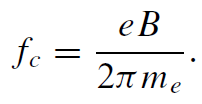
Cyclotron orbits
 المؤلف:
J. M. D. COEY
المؤلف:
J. M. D. COEY
 المصدر:
Magnetism and Magnetic Materials
المصدر:
Magnetism and Magnetic Materials
 الجزء والصفحة:
74
الجزء والصفحة:
74
 13-2-2021
13-2-2021
 1843
1843
Cyclotron orbits
If an electron travels with velocity v across a magnetic field B, the Lorentz force −ev × B causes an acceleration perpendicular to the velocity, which produces circular motion. Newton’s second law for the circularly accelerated motion gives f = mev2⊥/r = ev⊥B, so the cyclotron frequency fc = v⊥/2πr is proportional to the field:
 .........(1)
.........(1)
The angular frequency ωc equals 2πfc. Any component of the electron velocity parallel to the magnetic field is uninfluenced by the Lorentz force, so the trajectory is a helix around the field direction. Electrons which follow cyclotron orbits in vacuum radiate energy of frequency fc. The cyclotron frequency is 28 GHz T−1.
The cyclotron radius rc = mev⊥/eB is of order a few micrometres for electrons in metals when B ≈ 1 T. It is less for semiconductors and semimetals, where a smaller electron density leads to a lower Fermi velocity and the effective electron mass m may be less than me.
One example of the use of cyclotron radiation is the domestic microwave oven. Another is the synchrotron, where electrons accelerated to a large multiple γe of their rest energy and constrained to move in curved paths by bending magnets, emit linearly polarized white radiation in a narrow beam of width 1/γe radians. Synchrotron radiation is a valuable tool for probing the electronic structure of solids.
 الاكثر قراءة في المغناطيسية
الاكثر قراءة في المغناطيسية
 اخر الاخبار
اخر الاخبار
اخبار العتبة العباسية المقدسة


